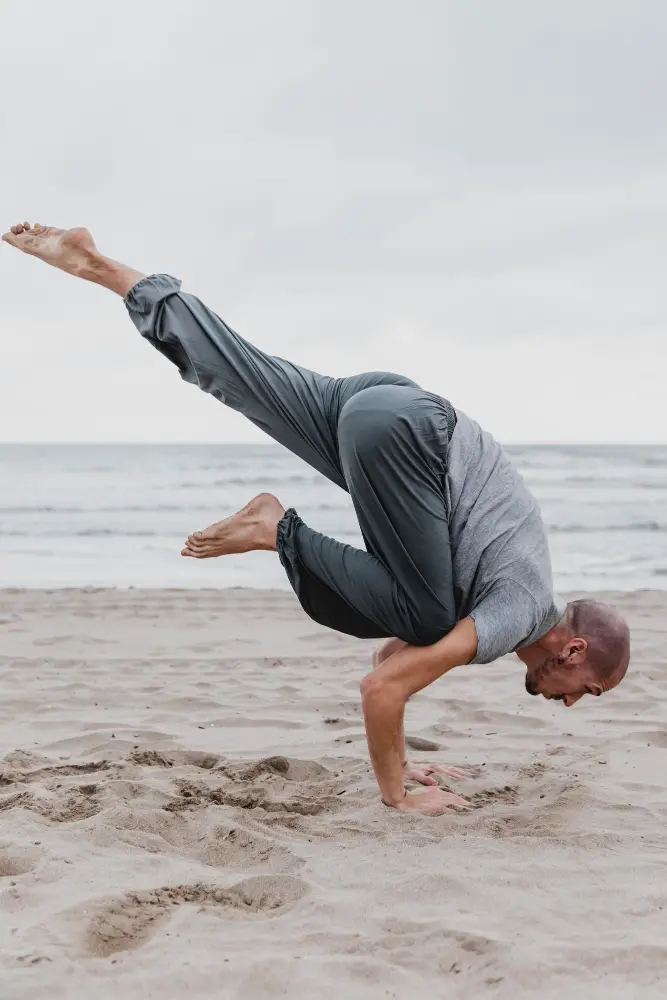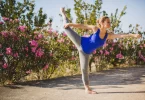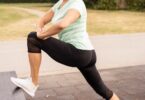Table of Contents
Introduction
Yoga isn’t just for women in leggings; it’s a powerful practice that offers incredible benefits for men too. Whether you’re looking to improve flexibility, build strength, or find some mental peace, yoga has something to offer. Let’s dive into the top 9 yoga poses every man should consider incorporating into his routine.
1. Downward Dog (Adho Mukha Svanasana)
How to Perform
Start on all fours, with your hands under your shoulders and knees under your hips. Lift your knees off the floor, straighten your legs, and push your hips up and back. Your body should form an inverted V shape.
Benefits
- Stretches the hamstrings, calves, and shoulders
- Strengthens the arms and legs
- Improves circulation
Common Mistakes to Avoid
- Avoid rounding your back; keep it straight.
- Don’t let your shoulders collapse; keep them engaged.
- Keep your heels as close to the floor as possible without forcing them.
2. Warrior I (Virabhadrasana I)
Steps to Perform
From a standing position, step one foot back about three to four feet. Turn your back foot out at a 45-degree angle. Bend your front knee while keeping your back leg straight. Raise your arms overhead, keeping your shoulders down and back.
Benefits
- Strengthens the legs, back, and shoulders
- Stretches the chest and lungs
- Improves balance and stability
Tips for Proper Alignment
- Keep your front knee directly above your ankle.
- Square your hips to the front of your mat.
- Engage your core for better balance.
3. Tree Pose (Vrksasana)
Performing the Pose
Stand tall with your feet together. Shift your weight onto one foot and bring the sole of your other foot to your inner thigh or calf (avoid the knee). Bring your hands to your heart or overhead.
Benefits
- Improves balance and coordination
- Strengthens the legs and core
- Enhances focus and concentration
Modifications for Beginners
- Use a wall for support if you’re struggling with balance.
- Place your foot on your calf instead of your thigh if needed.
4. Cobra Pose (Bhujangasana)
Steps to Perform
Lie face down with your hands under your shoulders. Press into your hands to lift your chest off the ground, keeping your elbows slightly bent and close to your body.
Benefits
- Strengthens the spine
- Stretches the chest, shoulders, and abdomen
- Improves posture
Precautions
- Avoid overextending your lower back.
- Keep your shoulders away from your ears.
5. Child’s Pose (Balasana)
How to Do It
Kneel on the floor, sit back on your heels, and fold forward, bringing your forehead to the mat. Stretch your arms out in front of you or alongside your body.
Benefits
- Stretches the hips, thighs, and ankles
- Calms the mind and relieves stress
- Gently stretch the lower back.
When to Use This Pose
- Use Child’s Pose as a resting position between more challenging poses.
- It’s great for cooling down after a workout.
Related Article: Explore incredible yoga poses for men over 50 in our detailed post, Incredible Yoga Poses for Men Over 50.
6. Seated Forward Bend (Paschimottanasana)
Performing the Pose
Sit with your legs extended straight in front of you. Hinge at your hips to fold forward, reaching for your feet or shins. Keep your back straight as you fold.
Benefits
- Stretches the hamstrings, spine, and lower back
- Calms the mind and reduces stress
- Improves digestion
Common Errors
- Avoid rounding your back; keep it long and straight.
- Don’t force yourself to reach your feet; go as far as comfortable.
7. Bridge Pose (Setu Bandhasana)
How to Perform
Lie on your back with your knees bent and feet flat on the floor, hip-width apart. Press into your feet to lift your hips towards the ceiling. Clasp your hands under your back for added support.
Benefits
- Strengthens the back, glutes, and legs
- Opens the chest and shoulders
- Improves spinal flexibility
Variations
- Place a block under your lower back for support if needed.
- Try lifting one leg at a time for an added challenge.
Related Article: Discover the top 5 yoga poses for men in our article on Transform Your Workout: Top 5 Yoga Poses for Men.
8. Plank Pose (Phalakasana)
Steps to Perform
Start on all fours, then step your feet back to come into a high push-up position. Keep your body in a straight line from head to heels, engaging your core.
Benefits
- Strengthens the core, arms, and shoulders
- Improves posture
- Enhances balance
Tips for Holding the Pose
- Keep your hands directly under your shoulders.
- Engage your core to prevent your hips from sagging.
9. Corpse Pose (Savasana)
How to Perform
Lie flat on your back with your legs extended and arms at your sides, palms facing up. Close your eyes and relax every muscle in your body.
Benefits
- Promotes deep relaxation
- Reduces stress and anxiety
- Helps lower blood pressure
Importance of Relaxation in Yoga
- Savasana allows your body to absorb the benefits of your practice.
- It’s essential for mental and physical recovery.
Related Article: For more tips on how to start yoga as a beginner, visit our Yoga for Men: How to Start as a Beginner guide.
FAQs
How often should men practice yoga?
It’s best to practice yoga at least 2-3 times a week to see noticeable benefits. However, even a short daily practice can make a significant difference.
Can yoga help with muscle building?
Yes, yoga can help build muscle strength, especially with poses like Plank and Warrior I. It’s a great complement to weight training.
Is yoga good for mental health?
Absolutely. Yoga is known for reducing stress, anxiety, and depression. The focus on breath and movement can be very calming.
What should beginners focus on in yoga?
Beginners should focus on learning the basics, like proper alignment and breathing techniques. It’s important to go at your own pace and not compare yourself to others.
Can yoga be combined with other forms of exercise?
Yes, yoga complements other forms of exercise well. It can improve flexibility and prevent injuries, making it a great addition to any fitness routine.
Conclusion
Incorporating these yoga poses into your routine can offer numerous benefits, from improved flexibility and strength to better mental clarity and reduced stress. Yoga is a journey, not a destination, so take your time and enjoy the process. Start with a few poses and gradually build up your practice. You’ll be amazed at how much better you feel both physically and mentally.







